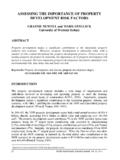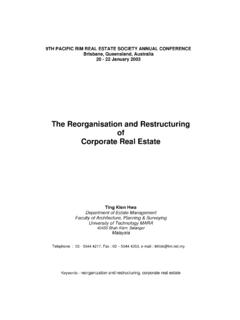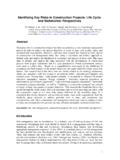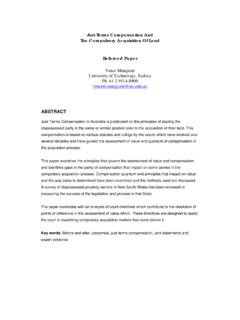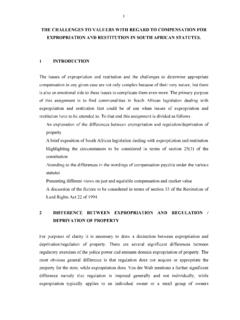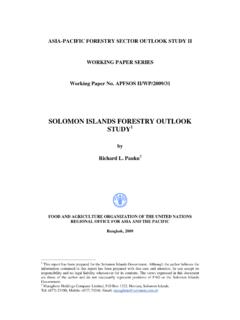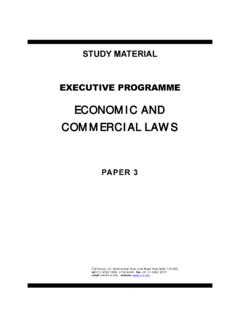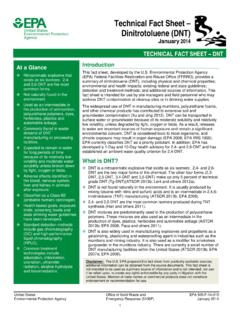Transcription of PROFITABILITY AND CAPITAL STRUCTURE OF THE …
1 PROFITABILITY AND CAPITAL STRUCTURE OF THE. property AND construction SECTORS IN. MALAYSIA. WAN MANSOR WAN MAHMOOD and ROZIMAH ZAKARIA. Universiti Teknologi MARA. ABSTRACT. This study examines the PROFITABILITY and CAPITAL STRUCTURE among property developers and constructors in emerging market of Malaysia. Using the sample of 25 property companies and 20 construction companies for a period of eight years, the present study suggests that developers are more profitable than contractors due to the fact that their CAPITAL gearing and debt equity ratio are less than those of contractors. The results from the regression analysis indicate that CAPITAL gearing is negatively related with net profit margins and price earning ratio for both property and construction sectors.
2 The findings show unequal business relationship with regards to debt and profit even though their business is very interrelated. Keywords: PROFITABILITY , CAPITAL STRUCTURE , property developer, contractor. INTRODUCTION. The construction and property sectors have played an important role in development of the Malaysian economy; particularly in the late 1980s to the mid-1990s. Through the creation of fixed assets, these sectors complement the other sectors in the economy by providing a basis of generating output, revenue, profit as well as employment, all of which are the necessary ingredients for promoting economic growth. However, these sectors are quite sensitive to economic conditions, with their prices soaring during booming times and melting during slumping times.
3 For instance, the falling of property prices in the early 1990s caused problems for financial institutions which use properties as collateral. Experience elsewhere has shown that a collapse of the property sector market can even lead to severe outcomes including bank failures. Prior to the Asian economic crisis, the construction sector had grown considerably, particularly since 1990. This sector grew rapidly at percent per annum during 1990- 1997 arising from the active property market and accelerated development of government infrastructure projects. It then reduced drastically in 1998 to register a negative growth of 23 per cent following the Asian financial crisis which saw the Malaysian economy turn into a severe downturn.
4 However, efforts undertaken by the government and private sector 92 Pacific Rim property Research Journal, Vol 13, No 1. in 1998 to revive these industries by lowering of interest rates has shown positive results. The construction sector registered productivity, employment and output growth of , and %, respectively, in 2000. The improvement is attributed to the utilisation of modern construction techniques and upgrading of the construction workforce. Even though the construction sector has shown improvement starting from 1999 onward and acts as a catalyst for a wide range of economic activities in the country, their contribution to the total Gross Domestic Product (GDP) is generally small, 4, , and per cent in 1998, 1999, 2000 and 2001 respectively.
5 Comparing with their property counterpart, local constructions are generally small and less profitable. The reason as mentioned by Ball, Farshchi and Grilli (2000) is that there is not much value added by contractors. Furthermore, they are dependent on developers' interim payments for much of the construction finance. Therefore, they become more financially dependent. The purpose of this paper is to provide insight into the performance of property developers and contractor's PROFITABILITY and factors impacting CAPITAL STRUCTURE decisions of these sectors in Malaysia. Thus, the key contributions of the study are to explore and expand on existing research from a different perspective.
6 It is the first study to provide comprehensive evidence on the performance of property and construction in the emerging market such as Malaysia over the time period from 1996 to 2003. Second, the present study focus on comparing these industries is justified since they are related in nature with minor contribution to economic growth. Third, the study sheds light on the implication of their relationship or lack of it and their competitiveness in contributing to the country economy. The major findings of our analysis can be summarized as follows. First, developers are larger and more profitable compared to contractors' counterparts. However, their CAPITAL gearing and debt equity ratio are less than those of contractors.
7 This is due to the fact that contractors are heavily burden with debt and thus, the need to service this debt is very high. This led to low pre-tax profit margin as well as profit margin. Second, for the construction sector , we find a highly significant negative relationship between CAPITAL gearing with all other variables. profit, pre tax profit and price earning ratio. For the property sector , the study finds a highly significant negative relationship only between CAPITAL gearing and profit and pre tax profit. However, a significant positive relationship between profit and pre tax profit and between profit and price earning ratio are found for both sectors.
8 Finally, using the aggregated annual data for the whole sample period, the results report statistically significantly differences between the mean values for all the financial indicators except for price-earning ratio. The remainder of the paper is organized as follows. Section 2 provides discussion of the background literature; section 3 contains a discussion of the data and measures of Pacific Rim property Research Journal, Vol 13, No 1 93. performance. A presentation of the methodology and the results contained in sections 5. and 6 presents the summary and conclusions. LITERATURE REVIEW. A number of recent papers have examined the PROFITABILITY and CAPITAL STRUCTURE in many developed Asian economies such as Hong Kong, Singapore and other industrialized countries.
9 As important as this issue is, however, there has been no attention given to the PROFITABILITY and CAPITAL STRUCTURE in developed country like Malaysia compared to the newly industrialize economies of Asia. Recent investigation by Chiang et al (2002) on the inter-relationship between PROFITABILITY , cost of CAPITAL and CAPITAL STRUCTURE among property developers and contractors focus on the Hong Kong market and find that developers are among the largest and most profitable in the world compared to their contractor counterparts. Their analysis of financial data also suggests that gearing is generally higher among contractors than developers. Similar results are obtained by Chiang and Chan (2001) who also study the Hong Kong property market and find that developers are large and PROFITABILITY by international standard, whilst their local building contractors are small and their markets are highly competitive.
10 There are a few studies conducted in either the property or construction sectors in the developed country. For instant, Barkham (1997) who studied UK property market concludes that property development firms borrow more than property trading firms. On a similar note, research by Ooi (1999b) concludes that UK developers employ more debt than contractors. He attributed the higher leverage to the fact that most property development projects are funded through project financing, which usually involves higher gearing. Another study by Ooi (1999a) on the CAPITAL STRUCTURE determinants of 83. property companies quoted in the UK between 1989 and 1995 finds that contrary to the theoretical predictions, corporate performance and tax burden do not appear to play any major role in the debt-equity choice of property companies.
